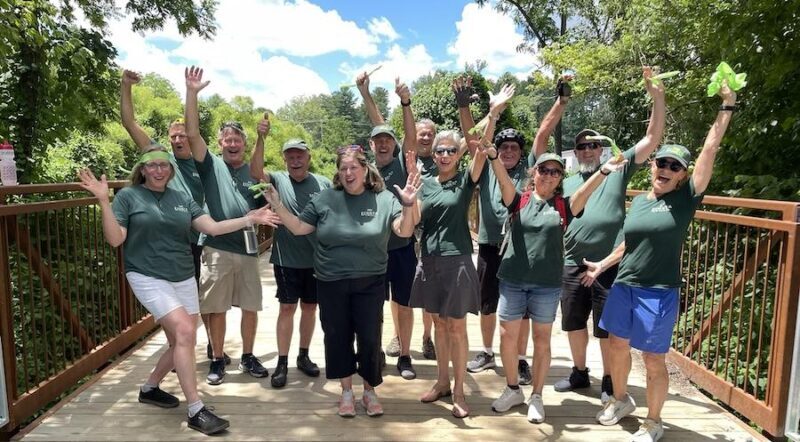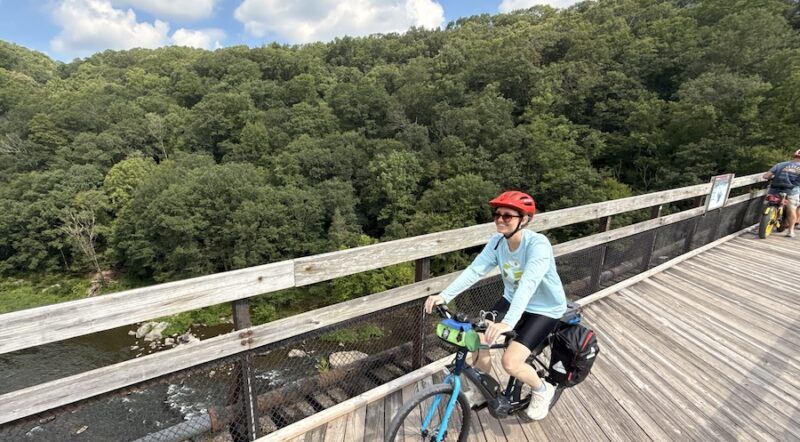Pennsylvania’s Heritage Rail Trail County Park and Maryland’s Torrey C. Brown Rail Trail
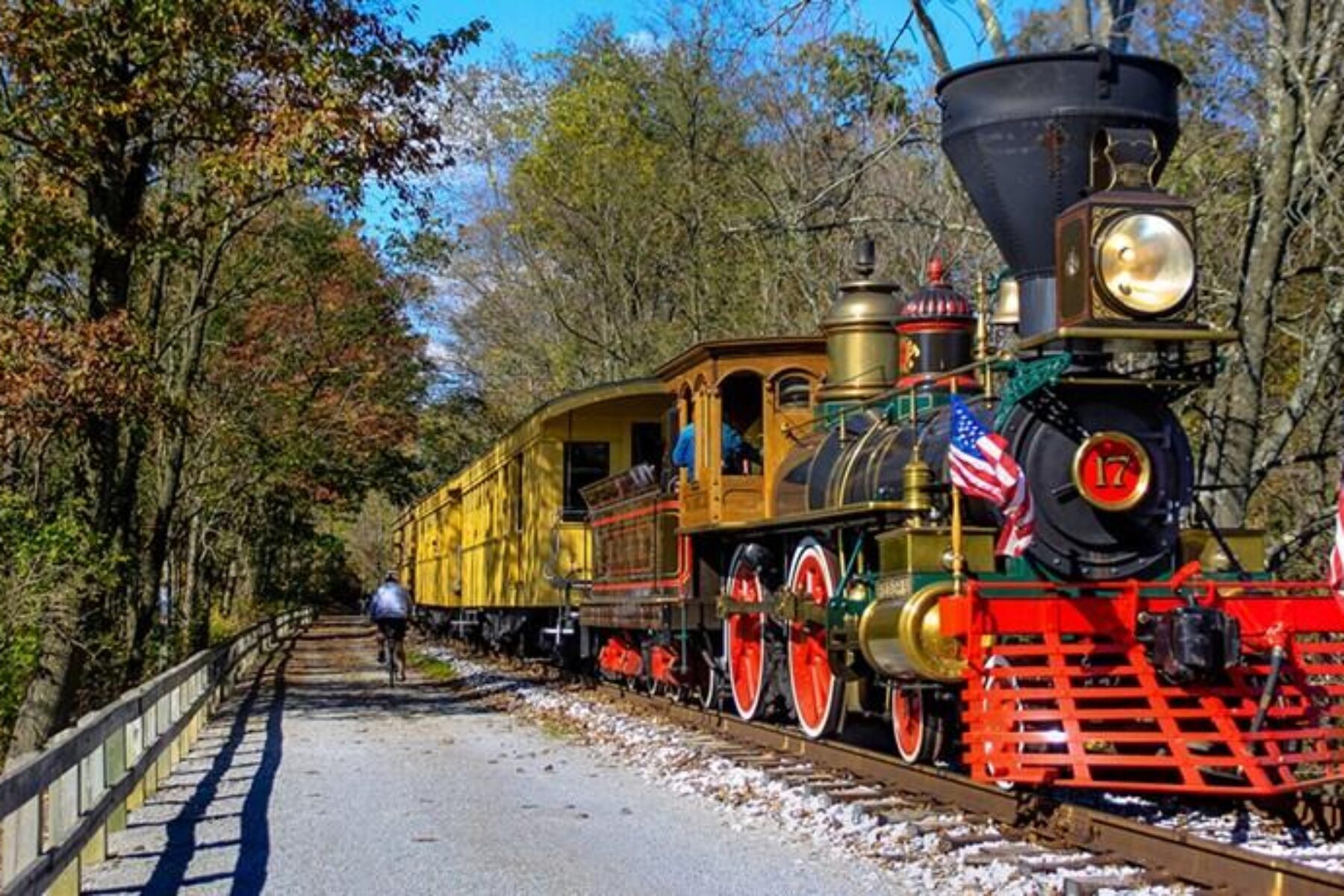
Trail of the Month: September 2015
“It’s an economic driver that encourages exercise and makes people feel emotionally revived.”
The visionary Grand History Trail began rather humbly. Nearly a decade ago, Don Gogniat was sitting at a meeting of the York County Rail Trail Authority, and as he listened to those around him talking about the region’s trails, he began quietly sketching them out on a napkin.
As he added the trails line by line, he saw something exciting begin to take shape: a map of a potential 250-mile Grand History Trail connecting dozens of historical sites and historically significant cities, including the nation’s capital, Annapolis, Baltimore, York, Hanover and Gettysburg.
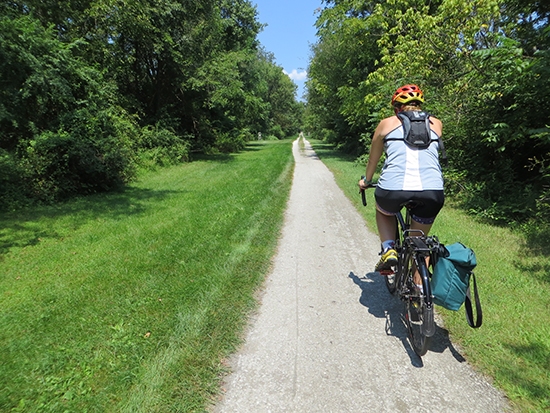
Today, one of the largest completed sections of that developing network is a pair of connected rail-trails—the Heritage Rail Trail County Park and the Torrey C. Brown Rail Trail—a 44-mile expanse of crushed stone across two states (Pennsylvania and Maryland) that, together, are the latest inductees into the Rail-Trail Hall of Fame by Rails-to-Trails Conservancy (RTC).
“The Grand History Trail is about health, wealth and joy,” says Gogniat. “It’s an economic driver that encourages exercise and makes people feel emotionally revived.” Noting that on the Heritage Rail Trail (HRT), “Everyone says hello to one another,” Gogniat often refers to it as “the friendliest place in York County.”
The past is tangible on this trail pair, which is the progeny of the former Northern Central Railroad. Old signposts, marked with a “W” to signal train engineers to blow their whistles, still dot the route, and three restored train depots—Hanover Junction and New Freedom in Pennsylvania, and Monkton in Maryland—house historical artifacts and educational displays. On the HRT, the Howard Tunnel dates back to the early 1800s; during the Civil War, Union Troops would station cannons on top to defend against Confederate attacks.
“It’s a very old rail corridor,” says Carl Knoch, chairman of the York County Rail Trail Authority, which developed the HRT. “It was constructed in the 1830s. Abraham Lincoln rode it from Baltimore to Hanover Junction to deliver the Gettysburg Address, and his funeral train took that route, too.” This year marks the 150th anniversary of Lincoln’s assassination and the railroad journey that transported his body to Springfield, Illinois.
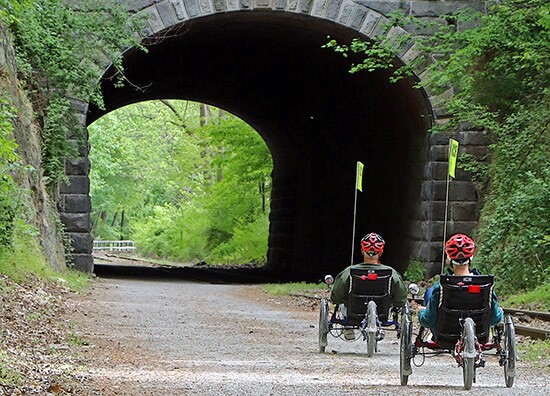
In November, a costumed Lincoln interpreter will board the Steam Into History excursion train that parallels the trail and give a recitation of the iconic president’s famed speech. Other historical figures, entertainers and musicians playing 19th century tunes can be found on the trains at other times throughout the year. The moving tourist attraction is pulled by a replica 1860s locomotive trimmed in bright red and shiny brass that runs 10 miles between New Freedom and Hanover Junction. The train, managed by a local nonprofit, began serving passengers in 2013, and Knoch notes that they even had to add extra train cars due to demand and may expand the route another 10 miles to York.
“It’s interesting to be on the trail and see this thing coming alongside of you,” says Tim Fulton, who was instrumental in the HRT’s development. “You get a sense of history, of what the corridor was all about: transportation.”
Fulton began working on the trail for the City of York in 1975, when he was in his mid-20s and just beginning to take biking seriously as an adult. With the opportunity ripe for a rail-trail in York County and across the border in Maryland, he felt “the significant size and scope of the project could be a standout in terms of trail development.”

In the late-1980s, a group of the trail’s advocates decided to walk about 20 miles down the corridor from York, Pennsylvania, all the way to the Maryland line to get a firsthand sense of what it was. The trip, atop railroad ballast stones, took a full day. Fulton remembers the corridor as an isolated place without viable links to the surrounding towns. The trail changed everything. Completed in 1999, Fulton now calls it “a centered place of community activity, connecting residences, businesses and places of employment.”
Building on that success, a 6-mile extension (along levees rather than a rail corridor) will continue the trail north through the city of York to the popular 150-acre John C. Rudy County Park. Most of the extension is currently open but disconnected from the main body of the trail by a 2-mile gap anticipated to be finished in 2017. A bald eagle’s nest sits very close to the new route, and Knoch remembers one of the eagles even flying overhead during the opening ceremony for that trail section north of the city.
On the opposite (southern) end of the HRT, the trail meets its mate at the Pennsylvania/Maryland state line. “It’s absolutely seamless,” says Gwen Loose, the executive director for the York County Rail Trail Authority, of the connection between the two trails. “If you’re bicycling fast, you won’t even notice.”
For those going at a slower pace, a large kiosk at the intersection displays a map of the Pennsylvania trail on one side and the Maryland trail on the other. A commemorative sign marking the historical Mason-Dixon Line is also displayed.
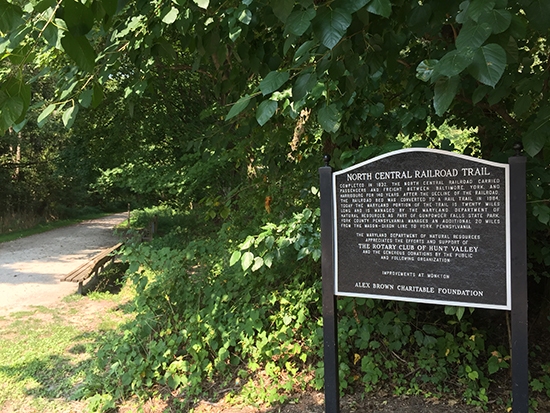
The TCB is one of the oldest rail-trails in America. Its first section opened in 1984 at a time when there were fewer than 200 rail-trails in the country and RTC, which has spearheaded the rail-trail movement, had not yet opened its doors (that came two years later). The Maryland Department of Natural Resources, led by Secretary Torrey C. Brown at the time, had the foresight to see the value of preserving the corridor, and the DNR still manages the rail-trail today as part of Gunpowder Falls State Park. Originally named the Northern Central Railroad Trail, the pathway was renamed in his honor in 2007.
Brian Kopp, an education coordinator for Bike Maryland, has been riding the trail since the early 1990s. “It’s become much, much busier,” he notes. “I never really saw many people back then, but now when you go on a Saturday, it’s jam-packed.”
RTC’s Katie Harris agrees; during her recent end-of-summer excursion on the trail, she noted that every trailhead parking lot along the way was bustling. She loved that the trail was “just green everywhere” as well as the sereneness of Big Gunpowder Falls, which parallels the trail’s southern end. The river’s icy cold waters make for a refreshing dip in the summer as well as a world-class trout stream.
A lot of people use the trail to access the water for tubing and kayaking and fishing.
“A lot of people use the trail to access the water for tubing and kayaking and fishing,” says Knoch. At Monkton Station, both inner tubes and bikes can be rented, making it one of the most popular spots on the trail. A slow march of people with the colorful floats atop their heads can often be seen walking.
“One summer, we assigned a volunteer to count one-way pedestrian and bicycle traffic at Monkton Station,” says park ranger Dean Hughes. “They counted 1,300 people per hour passing through during peak weekend times.”
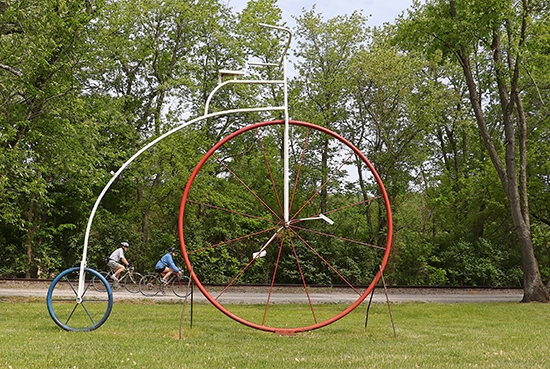
Now, on the cusp of fall, the timing couldn’t be better to plan a ride on the pathway pair. Loose notes that along the Heritage Rail Trail, “It’s not just the trees that are gorgeous; the cornfields turn a beautiful shade of straw.” And Kopp calls an autumn ride through the tree tunnels of the Torrey Brown a “stunning experience” and his favorite time to experience the trail.
With the region’s trails growing and becoming more popular, Gogniat is more hopeful than ever for the Grand History Trail that would connect so many of them. Although the original concept fizzled when the recession hit, more than half the trail network—140 miles—is already open, and excitement is once again building.
“This is something that will be finished,” says Gogniat. “It makes too much sense not to do it. It’s just a matter of time.”

Donate
Everyone deserves access to safe ways to walk, bike, and be active outdoors.
